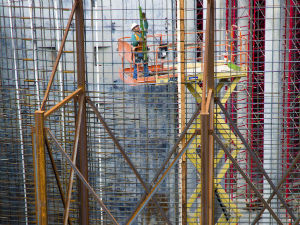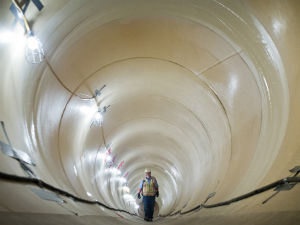
Interested in Education/Training?
Get Education/Training articles, news and videos right in your inbox! Sign up now.
Education/Training + Get AlertsJust 25 years ago, the freeway-flattening 6.9 magnitude Loma Prieta earthquake hit northern California, collapsing structures and calling attention to Bay Area infrastructure — particularly the water system. Since then, the race has been on to complete work before another major earthquake hits the region.
 In 2002, San Francisco voters approved a proposition to retrofit, repair and replace the aging pipelines, dams and tunnels that make up the Hetch Hetchy Regional Water System. The Water System Improvement Program (WSIP) had a simple goal: to ensure that within 24 hours of a major earthquake, the 2.6 million people relying on the system would have drinking water.
In 2002, San Francisco voters approved a proposition to retrofit, repair and replace the aging pipelines, dams and tunnels that make up the Hetch Hetchy Regional Water System. The Water System Improvement Program (WSIP) had a simple goal: to ensure that within 24 hours of a major earthquake, the 2.6 million people relying on the system would have drinking water.
“We’re in a race against time to protect and retrofit our local and regional water infrastructure,” says Harlan Kelly, Jr., SFPUC general manager. “The WSIP is creating a lifeline around the Bay to ensure we can reliably provide water to customers after an earthquake.”
This year marks the 10th anniversary since the start of WSIP construction. The program is now 80 percent complete, has repaired or replaced more than 280 miles of pipelines and has put thousands of employees to work.
Local jobs made possible
Key to the program’s success has been the Project Labor Agreement, which governs labor engagement for all WSIP projects.
Adopted in 2007, the PLA supports individuals, contractors and organizations as they work on SFPUC’s infrastructure projects. The PLA also makes sure these projects are on schedule, on budget and meet safety standards.
“Under our PLA, we have delivered projects on schedule, with no work stoppages and with labor harmony,” says Masood Ordikhani, director of the SFPUC Infrastructure Workforce and Economic Program Services Bureau. “If WSIP isn’t done well, it could have widespread impacts, since we don’t know when the next earthquake will hit the Bay Area.”
But better yet, the PLA has meant jobs — and lots of them. As of June 2014, 11,219 workers have completed 6.25 million craft hours on WSIP projects, earning wages in excess of $374 million.
“The WSIP has been a blessing during the recession,” Ordikhani said. “It’s provided job opportunities, living wages and benefits for service-territory residents and their families.”
Through its Job Training and Opportunities Program, the SFPUC works with local and regional job training providers and community organizations to offer training programs. The program aims to reach people who face immense barriers to employment, helping them secure meaningful, well-paying jobs on WSIP projects.
 By working with apprentices or entry-level workers, the SFPUC has helped workers move from novice positions to experts all within the WSIP program, or, in some instances, even on just one or two of the larger projects.
By working with apprentices or entry-level workers, the SFPUC has helped workers move from novice positions to experts all within the WSIP program, or, in some instances, even on just one or two of the larger projects.
“Through WSIP’s job training programs, we’ve been able to help people get jobs that translate into careers with family-sustaining wages and benefits,” Ordikhani says.
The SFPUC’s training and career development programs focus on those living in San Francisco and within the SFPUC’s seven-county service territory. Currently, San Francisco and SFPUC service territory residents work 72.5 percent of all apprentice hours.
San Francisco resident Tobias Bailey knows first-hand how the program can benefit those entering the construction industry. While looking for new career opportunities, Bailey discovered Alameda County’s Cypress Mandela Training Center, Inc., which offers free training for construction careers. After completing Cypress’ pre-apprentice program, training staff recommended Bailey compete for a coveted spot on the Miner Tender Preparedness Program. Bailey not only earned his spot, but excelled in the training program, which included a training session in Arizona to practice mining skills in a working mine owned and operated by the University of Arizona.
At the end of his time in Arizona, Bailey placed second among the graduates and was hired in 2011 to work on the SFPUC’s Sunol Valley Water Treatment Plant Expansion and Treated Water Reservoir project.
“I enjoy going to work every day and paying my taxes. Without CityBuild or Cypress Mandela, I don’t think I would be able to access the skills I now have,” Bailey says.
Similar programs include a Trimble GPS Grade-Setting and Navigation Training Program with the Operating Engineers’ Local #3 and a Concrete Expo and Concrete Formwork Training Program with the Carpenters Training Committee of Northern California.
Small and local businesses
Putting the region to work is a major goal of the WSIP, and although the PLA has a robust program to employ individuals, it takes a similar approach to help small and local businesses.
The SFPUC’s Small Firm Advisory Committee meets with regional businesses and representatives of contractors and builders exchanges to connect them with SFPUC projects. Through partnerships in local regions, the SFPUC has enabled small businesses to get a start in the construction world.
Clifton Burch, the owner of Empire Engineering and Construction has successfully worked with SFPUC partners. Burch, who had spent more than 20 years in the construction industry, decided to start his own contracting company. He began working with an SFPUC partner, the Bayview Renaissance Center, to acquire a small business loan. Burch also enrolled in an entrepreneur program with SFPUC’s partner organization, Merriwhether and Williams Insurance Services.
Empire Engineering now employs more than 30 people and works with several local small businesses as subcontractors.
“We are very proud of our roots and our experience with Merriwether and Williams and the Bayview Renaissance programs. Having graduated from both, as well as the Caltrans & AGC Mentor/Protégé program, we can attest to the quality and importance of these programs for helping develop small businesses,” Burch says.
To expand the program, the SFPUC launched the Contractors Assistance Center in Bayview-Hunters Point last year.
The center offers a range of free programs including classroom training, networking events and one-on-one counseling that help construction contractors, professional services consultants, service providers, suppliers and non-profits access contracting opportunities. Through its programs, contractors can meet with prime contractors to identify and pursue city opportunities with the SFPUC, and even other departments, such as the Department of Public Works, Municipal Transportation Agency, Airport, and the Port.
The Contractors Assistance Center will become more important in upcoming years as the SFPUC launches the Sewer System Improvement Program (SSIP), a multi-billion dollar program to upgrade San Francisco’s aging sewer system.
Unlike the WSIP regional program, the sewer program is exclusively within San Francisco. Upgrading the Southeast Treatment Plant, which treats more than 80 percent of the city’s sewage and stormwater is the focal point of the SSIP. Because it is located near Bayview residences, the SFPUC is focusing on working closely with those neighbors as the plant upgrades are implemented.
“Our goal is to establish meaningful opportunities within the Bayview community,” says Kelly. “We have a responsibility to be accessible and responsive in the neighborhoods in which we invest billions of dollars of work.”
The immense amount of time, effort and care put into the PLA for SFPUC’s infrastructure programs have paved the way for establishing relationships with local unions, contractors and community-based organizations.
“We have reached out extensively to the local community about the sewer system upgrades, but we still have to do more,” Ordikhani said. “As we implement these large-scale infrastructure upgrades, we will continue looking to the residents of San Francisco to help us build a better community for themselves, and their families, friends and peers, for generations to come.”





